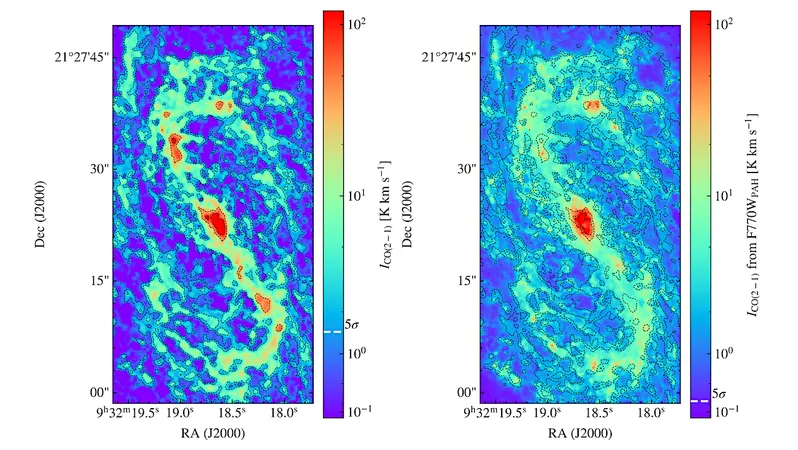
Unveiling the Cosmic Connection: CO(2-1) and Polycyclic Aromatic Hydrocarbons in Star-Forming Galaxies
2024-10-10
Author: John Tan
Introduction
In a groundbreaking study, astronomers have utilized the Atacama Large Millimeter/sub-millimeter Array (ALMA) and the James Webb Space Telescope (JWST) to explore the intricate relationship between carbon monoxide (CO) emissions and polycyclic aromatic hydrocarbons (PAHs) in 66 nearby star-forming galaxies. This ambitious project has significantly expanded our understanding by increasing the sample size for CO(2-1) mapping studies by over tenfold, all at a remarkable spatial resolution of ~100 parsecs.
Methodology
The research highlights how researchers focused their attention on the molecular gas regions within these galaxies, uncovering strong correlations between CO(2-1) emissions and specific PAH emission features detected at infrared wavelengths. Using JWST’s F335M, F770W, and F1130W filters, they measured PAH emissions at 3.3 microns, 7.7 microns, and 11.3 microns, respectively. The findings reveal power law relationships that suggest only minor variations in the CO-to-PAH ratios across different regions of the galaxies examined.
Results
Interestingly, the study indicates that CO-to-PAH ratios and scaling relations in the vicinity of HII regions—where significant star formation occurs—are notably similar to those found along more diffuse sight lines. However, HII regions display higher intensities across all traced emissions. Conversely, the centers of galaxies show elevated intensities and enhanced CO-to-PAH ratios when compared to their disk counterparts.
Analysis
Additionally, the results indicate a 0.19 dex scatter in the normalization of CO emissions at fixed PAH intensities, revealing an intriguing anti-correlation with the specific star formation rate relative to stellar mass. This suggests a nuanced link between the active star formation within a galaxy and its physical and chemical composition.
Conclusion
To aid in the understanding of these observations, the researchers propose a model that takes into account the observable variations across different galaxies. This model serves as an empirical tool for estimating CO(2-1) intensity based solely on PAH emission, thus harnessing the power of the JWST's unparalleled sensitivity and resolution to map cold gas in the universe.
Future Implications
As we continue to explore the cosmos, this innovative research not only paves the way for future studies into star formation and molecular gas dynamics but also enhances our overarching understanding of the lifecycle of galaxies. Stay tuned for more exciting updates from the world of astrophysics as we unravel the mysteries of our universe!


 Brasil (PT)
Brasil (PT)
 Canada (EN)
Canada (EN)
 Chile (ES)
Chile (ES)
 España (ES)
España (ES)
 France (FR)
France (FR)
 Hong Kong (EN)
Hong Kong (EN)
 Italia (IT)
Italia (IT)
 日本 (JA)
日本 (JA)
 Magyarország (HU)
Magyarország (HU)
 Norge (NO)
Norge (NO)
 Polska (PL)
Polska (PL)
 Schweiz (DE)
Schweiz (DE)
 Singapore (EN)
Singapore (EN)
 Sverige (SV)
Sverige (SV)
 Suomi (FI)
Suomi (FI)
 Türkiye (TR)
Türkiye (TR)